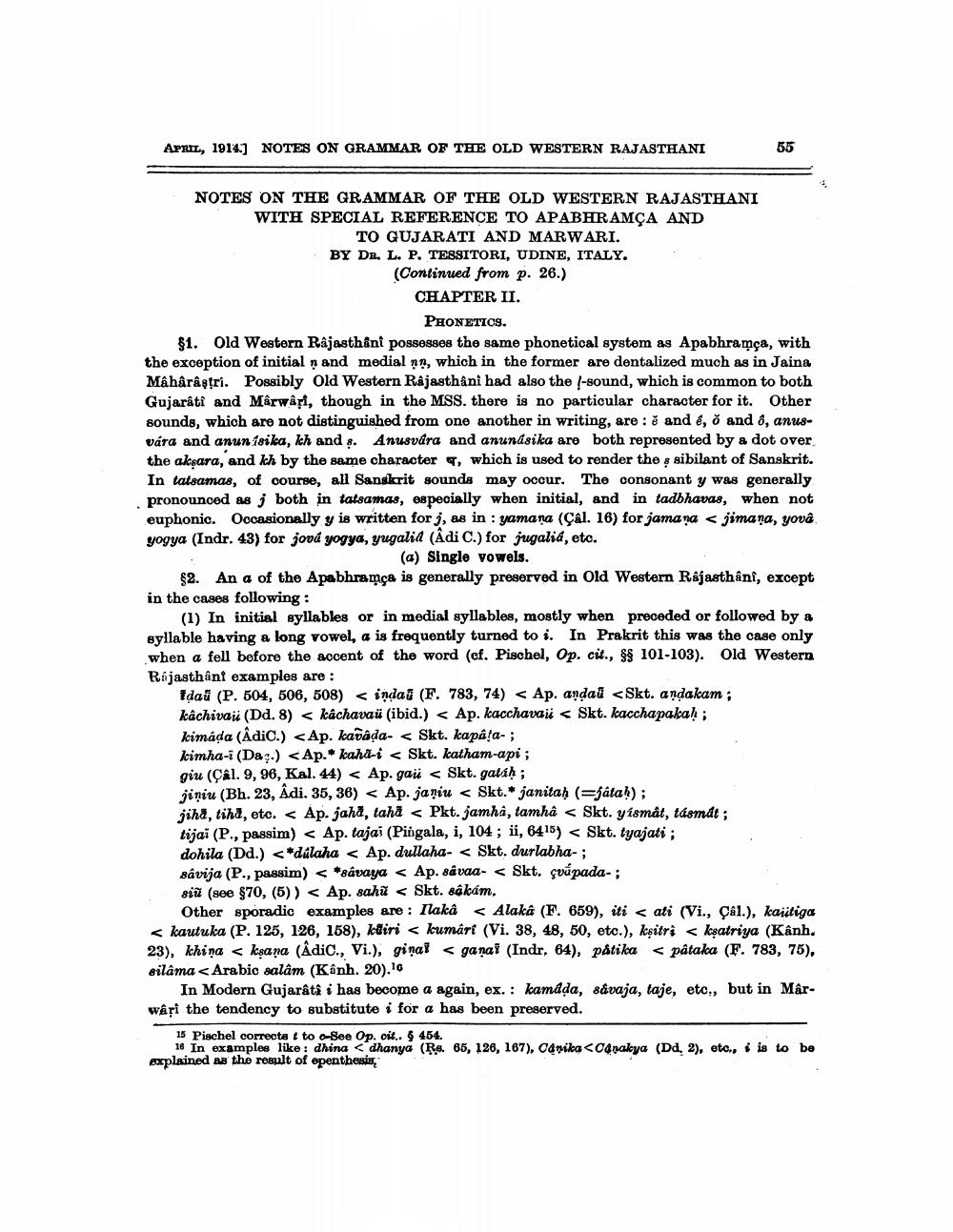________________
APRIL, 1914.] NOTES ON GRAMMAR OF THE OLD WESTERN RAJASTHANI
55
NOTES ON THE GRAMMAR OF THE OLD WESTERN RAJASTHANI WITH SPECIAL REFERENCE TO APABHRAMCA AND
TO GUJARATI AND MARWARI. BY DR. L. P. TESSITORI, UDINE, ITALY.
(Continued from p. 26.) CHAPTER II.
PHONETICS. $1. Old Western Rajasthani possesses the same phonetical system as Apabhramça, with the exception of initial n and medial nn, which in the former are dentalized much as in Jaina Mâhârâştri. Possibly Old Western Rajasthani had also the /-sound, which is common to both Gujarati and Marwari, though in the MSS. there is no particular character for it. Other sounds, which are not distinguished from one another in writing, are : 7 and 6, and 8, anusvára and anun 18ika, kh and s. Anusvára and anundsika are both represented by a dot over the aksara, and Ich by the same character , which is used to render the $ sibilant of Sanskrit. In tatsamas, of course, all Sanskrit sounds may occur. The consonant y was generally pronounced as j both in tatsamas, especially when initial, and in tadbhavas, when not euphonic. Occasionally y is written for j, as in : yamana (Çal. 16) for jamana < jimana, yova yogya (Indr. 43) for jová yogya, yugalia (Adi C.) for jugalia, etc.
(a) Single vowels. $2. An a of the Apabhramça is generally preserved in Old Western Rajasthani, except in the cases following:
(1) In initial syllables or in medial syllables, mostly when preceded or followed by a syllable having a long vowel, a is frequently turned to i. In Prakrit this was the case only when a fell before the accent of the word (cf. Pischel, Op. cit., $S 101-103). Old Western Rajasthant examples are :
Idau (P. 504, 506, 508) < indau (F. 783, 74) < Ap. andaŭ <Skt. andakam ; kâchivait (Dd. 8) < kachavaü (ibid.) < Ap. kacchavaii < Skt. kacchapakah; kimada (Adic.) <Ap. kavada- < Skt. kapa!a- ; kimha-i (Da.) < Ap.* kaha-i < Skt. katham-api ; giu (Çal. 9, 96, Kal. 44) < Ap.gaü < Skt. gatsh; jiniu (Bh. 23, Adi. 35, 36) < Ap. janiu < Skt.* janitah (=játal); jiha, tiha, eto. < Ap. jaha, taha < Pkt. jamha, tamhâ < Skt. yismát, tásmdt; tijai (P., passim) < Ap. tajai (Pingala, i, 104 ; ii, 6415) < Skt. tyajati ; dohila (Dd.) <*dilaha < Ap. dullaha- < Skt. durlabha- ; savija (P., passim) < *savaya < Ap.savaa- < Skt. çoúpada- ; siū (see $70, (5)) < Ap. sahữ < Skt. sakam.
Other sporadic examples are : Ilakâ s Alaka (F. 659), iti s ati (Vi., Çal.), kaiitiga < kautuka (P. 125, 126, 158), kliri < kumart (Vi. 38, 48, 50, etc.), ksitri < ksatriya (Kanh. 23), khina s ksana (Adic., Vi.), ginat < ganai (Indr. 64), påtika < påtaka (F. 783, 75), silama <Arabic 8a âm (Kênh. 20). Ở
In Modern Gujarati i has become a again, ex. : kamada, såvaja, taje, etc., but in Marwâri the tendency to substitute i for a has been preserved.
15 Pischel correcta i to -See Op. cit.. $ 454.
16 In examples like : dhina dhanya (Rs. 85, 126, 167), Canika <Canakya (Dd. 2), etc., i is to be explained as the result of epenthesis,




